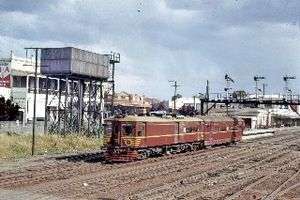Creamy Kate and Trailer
Creamy Kate was a New South Wales Government Railways railmotor, numbered 38. It was an evolution of the CPH railmotor class.
| BPH38 | |
|---|---|
 Creamy Kate in Junee | |
| Manufacturer | New South Wales Government Railways |
| Built at | Eveleigh Carriage Workshops |
| Constructed | 1934 |
| Entered service | 1934-83 |
| Number built | 1 |
| Fleet numbers | 38 |
| Specifications | |
| Car length | 16.76 metres |
| Width | 2.92 metres |
| Height | 3.92 metres |
| Traction system | Leyland petrol 1934-58) GM 6.71 diesel (1958-80) |
| Track gauge | 1,435 mm (4 ft 8 1⁄2 in) |
Overview
In the 1920s, the New South Wales Government Railways took delivery of 35 CPH railmotors for to replace locomotive-hauled passenger trains on lightly trafficked lines with a low patronage. With their popularity, patronage had increased beyond the normal operating capabilities and it had become clear that a larger and more powerful railmotor was needed.
The main problem standing in the way of development was finding a suitable large internal combustion engine to power this larger vehicle. A larger engine with enough power would lower the power-to-weight ratio and consequently defeat the purpose of the Rail Motor. This meant that existing steam trains and Rail Motors would have to be alternated to meet service requirements.[1]
A solution was found in building a railmotor with two engines in the form of a 150 hp (110 kW) 6-cylinder Leyland petrol engine and Lysholm-Smith hydraulic transmission. A similar vehicle had been built in 1933 by the Northern Counties Committee division of the London Midland & Scottish Railway and proved successful.
The Rail and Road Motor Engineer, NE Stafford supervised the building of these new vehicles in the Eveleigh Carriage Workshops and railmotor BPH38 emerged from the workshops in June 1934. Externally it was similar to the 42-foot (12.80 m) CPHs, but was considerably longer at 55-foot (16.76 m).[1]
It was nicknamed Creamy Kate after being released in a livery of cream with blue lining. A matching trailer carriage, CT81, was built to the same size and design as 38 on the underframe of carriage BX 1048 that had been damaged in an accident at Bowning.[1]
The pair were allocated to Dubbo for use on services to Orange, Molong and Coonamble. In 1949, BPH38 was reallocated to Narrandera where it operated with 400 class railmotors on services to Hay and Tocumwal connecting with the Riverina Express. In 1958 the Leyland petrol engines were replaced with GM 6.71 engines.[1]
In the 1970s, BPH38 was reallocated to Werris Creek to operate services on the Barraba line from Tamworth connecting with the Northern Mail and Northern Tablelands Express. It returned to Narrandera, back to Werris Creek, back to Narrandera and finally to Cowra where it operated services to Harden to connect with the Riverina Express and South Mail.[1]
With the replacement of many branch line services by road coaches, BPH38 became surplus to requirements and was condemned in April 1983 and sold to the Dorrigo Steam Railway & Museum.[1][2]
Meanwhile, trailer CT81 was renumbered 551 in 1945. It was sent to Sutherland in 1958 and operated with CPH railmotors on Sutherland to Helensburgh services on the South Coast railway line. Following the electrification of the line to Waterfall in July 1980, it was stored, condemned in April 1983 and sold to the Dorrigo Steam Railway & Museum.[1][2]
References
- Cooke, David (1984). Railmotors and XPTs. Australian Railway Historical Society NSW Division. pp. 36–39. ISBN 0 909650 23 3.
- Railmotors Dorrigo Steam Railway & Museum